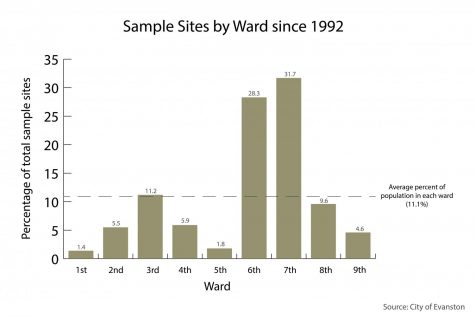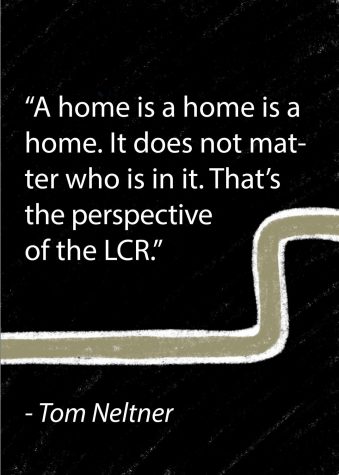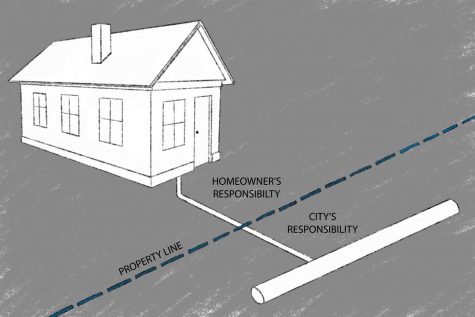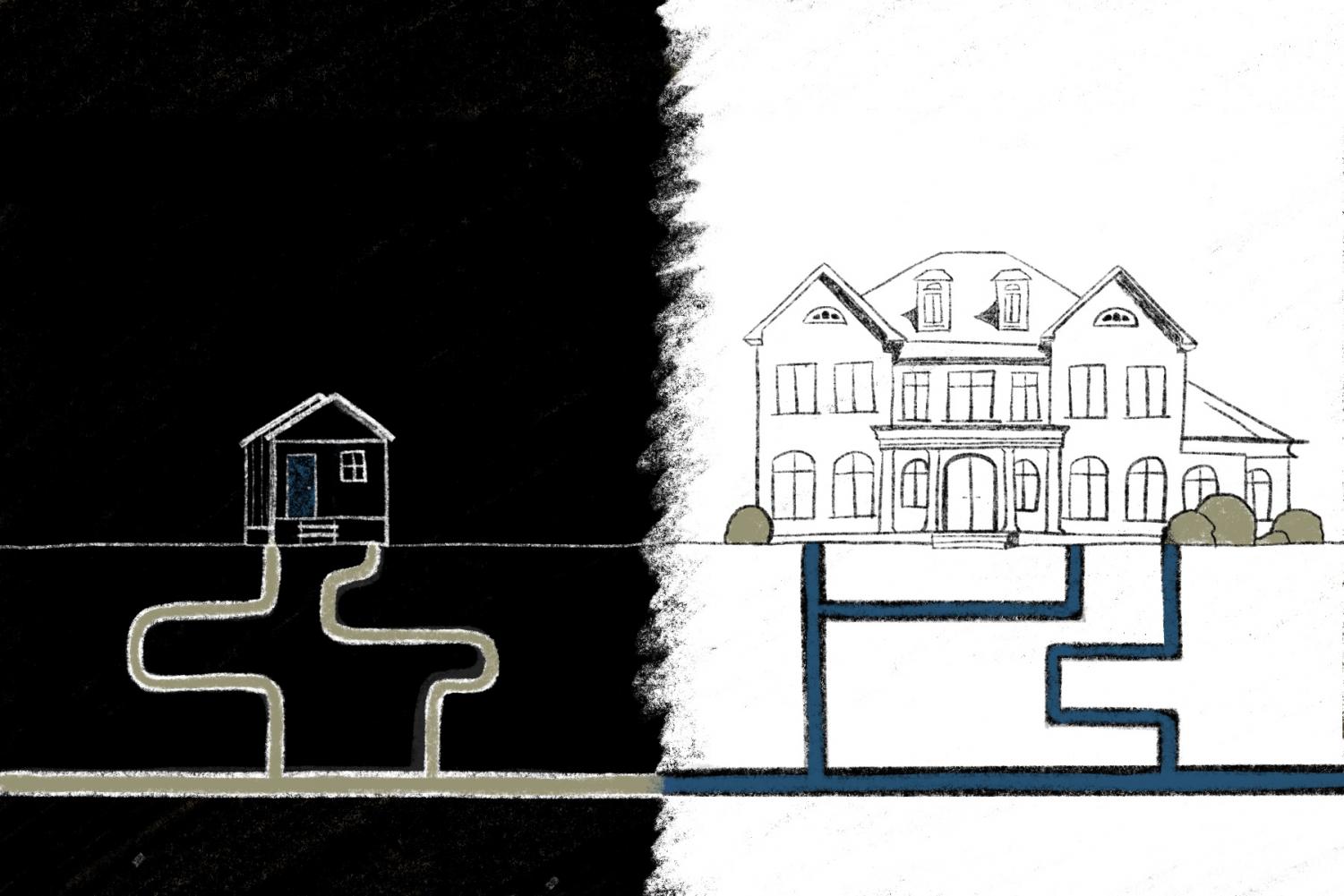In Focus: Loopholes in federal lead law left 5th Ward in the dark about what is in its water
December 22, 2020
Second Ward resident Regina Sant’Anna has helped her elderly neighbor carry hundreds of boxes of bottled water from her car to her home. Living on the border of the historically Black 5th Ward, Sant’Anna has noticed that some residents are concerned about their water quality.
“At times in underserved communities of color, brown or Black, you have a lot of people investing in (bottled) water,” Sant’Anna said. “You have to put in your budget plastic bottled water, because you do not trust the water systems.”
Sant’Anna’s neighbor is one of many Evanston residents concerned about their drinking water. Home to Evanston’s only waste transfer station, the 5th Ward specifically has suffered from discriminatory environmental policies that impact residents’ air quality and health. While the reasons for distrust may vary, the 2014 Flint, Mich. water crisis renewed city-wide concern for lead in water.
For about two decades, Evanston collected more than 180 water samples from residents’ homes to test for lead contamination. Yet in that time, the city only tested Evanston’s historically Black 5th Ward twice. Left untested, lead in water can have damaging and long-lasting health effects.
Ald. Robin Rue Simmons (5th) said she believed the water department diversified the sample pool since it first started testing, but grew concerned when she found out in June that the 5th Ward had only been tested twice since 2002. After The Daily Northwestern began investigating this issue, she pushed for a representative sample pool in the 2020 testing period, leading to six more samples from the 5th Ward, and is now pushing for a resolution to mandate equitable water testing.
“We have families that need to know if they are vulnerable to unhealthy lead levels in their water,” she said. “The results are incomplete.”
The U.S. Environmental Protection Agency’s Lead and Copper Rule of 1992 (LCR) requires all community water systems, including cities like Evanston, to routinely sample their water for lead contamination. However, The Daily Northwestern’s analysis of sampling sites found Evanston’s procedures are not reliable and not representative of the city’s population.
Prior to the 2020 testing period, 60 percent of all water samples had come from the historically White and wealthier 6th and 7th Wards. Meanwhile, the 5th Ward made up 10.4 percent of the city’s population in 2010 but only 1.8 percent of the sampling pool.

The 5th Ward has historically suffered from discriminatory policies. Early 20th century redlining segregated Black residents and zoned the ward to disincentivize economic growth. Educational, environmental and health disparities persist to this day. Undersampling in lead water testing may add to the 5th Ward’s long history of disadvantage.
“5th Ward residents are just as concerned about the health of their families as a resident in the 6th or the 7th Ward,” Rue Simmons said. “It’s unacceptable to have one targeted neighborhood in a community as diverse as Evanston included in our testing.”
Lead has significant adverse health impacts throughout the human lifespan. Feinberg pediatrician Helen Binns said lead poisoning in children may be linked to attention deficiency, increased probability of juvenile delinquency, difficulty with fine motor skills and a decrease in IQ points. Adults may experience elevated blood pressure, dental and gum disease and decreased cognitive ability. These effects can occur even in small amounts of exposure.
With revisions underway for the LCR, there are no plans to change the flawed sampling procedure. The federal rule’s poor regulation of sampling leaves low-income and minority communities in the dark about what is in their water.
Tom Neltner, chemicals policy director of the Environmental Defense Fund, was appointed to the EPA-created Lead and Copper Rule Working Group in 2014. Neltner helped coordinate and manage a lead line replacement webinar with Evanston’s water department early last year.
“I’ve talked to some of the officials in Evanston, and I think they’re trying their hardest,” Neltner said in April. “You need to build a system that recognizes it and accommodates people of color and low-income people so that they can participate.”
A federal rule full of holes
Evanston’s water quality reports have assured city officials and water advocates of safe drinking water for nearly 30 years, and Evanston’s water production bureau chief Darrell King said in March that the city is in “full compliance” with the LCR.
Most residents take the city’s compliance to mean they can trust Evanston’s water. In the 77 years she has lived in the city, 5th Ward resident and environmental activist Janet Alexander Davis has rarely heard concerns about water raised by residents. She participates in the western Evanston block club where her neighbors can air their grievances. In their recent meetings, she said water quality has not been raised as an issue.
“Water wasn’t on anybody’s mind,” Alexander Davis said.
But this trust is based on standards set by the LCR — which have been criticized for a variety of flaws, including the way lead is tested. Even though Evanston follows the law, the LCR’s regulations cause oversampling in North Evanston, while most other wards are left in the gutter.
Statistics Prof. Bruce Spencer said Evanston appears to be using the cluster sampling method to test lead levels. Sample sites are sorted into groups — in this case, wards and streets. Then, several sample sites are picked within those areas. In 2017, over one-third of Evanston’s samples were on the same street as two or more other samples.
“People do cluster samples to save money, so there’s less travel here,” Spencer said, “but it’s also usually true that you get less information from the same size sample and same number of observations in a cluster sample than you do in a non-clustered sample.”
Spencer said the sample was also impacted by a “non-response bias,” because the water department only tests homes that agree to be sampled.
Political science Prof. Reuel Rogers, who studies race and politics, said non-response biases in government sampling tend to disproportionately affect communities of color, potentially leading to a skewed data set.
“Putting the onus on residents to opt into testing via this convenience sampling approach is liable to reinforce pre-existing disparities in civic engagement,” Rogers said. “Wealthy and White households tend to participate at higher rates than poor and non-White households, especially in political acts that require individual initiative and access to information.”
The LCR does not have any requirement to avoid cluster sampling or minimize non-response bias.
Ninety percent of a city’s sample sites must have lead levels below 15 parts per billion to pass routine inspection, but this standard is not health-based, Binns said.
“The Lead and Copper Rule standard, to my understanding, was set at that level because it was a doable level for the facilities,” Binns said.
According to the World Health Organization, there is no known safe level of lead exposure. Proposed revisions to the LCR would lower the U.S. standard to 10 ppb, similar to the European Union’s standard. Illinois requires schools and daycares to notify parents when the lead level exceeds five ppb because of the potential to harm child development.
Evanston resident Stephen McComb wanted to change his lead pipes for the health of his family. After learning about the effects of lead on child development, he took it upon himself to replace his pipes and recommend plumbers to fellow residents who wanted to as well.
“Everybody now, if you look at the language around it, will say we’re below the EPA recommended level. No, the EPA is not recommending a level — they’re saying the only thing that’s safe is zero,” McComb said in March.
On top of a standard that does not consider health impacts, McComb said the EPA’s sampling procedure is not representative. Of all the 438 water samples Evanston has tested for lead prior to 2020, The Daily found that 139 were in the 7th Ward and 124 were in the 6th Ward. The 5th Ward was only tested eight times, with only two of those tests occuring in the last two decades.
One reason for that skewed sample may be that the LCR requires Evanston collect samples from “tier 1” sites, which are single-family homes that have plumbing systems with lead. The provision exists so all water samples come from still water.
“You need to get water that’s been setting for a long time in somebody’s house or setting for a long time in a pipe to see how much lead might be leaching into it,” Neltner said. “It’s really tough to do that in an apartment building.”
According to Evanston’s Zoning Map, there are single-family homes in every ward, although the 1st Ward is primarily zoned for the University and downtown district. Nancy Loeb, the director of Pritzker School of Law’s Environmental Advocacy Center, said the requirement to test single-family homes biases the sample toward wealthier residents.
“I find it troubling because many low-income people actually live in multi-unit rentals where the landlords don’t have an incentive to spend money to protect people,” she said in February. “That distinction may actually make it less likely that you’re going to capture areas where there are likely to be lead pipes.”

Neltner said the LCR does not intend to assess how much lead is in drinking water, but rather the effectiveness of chemicals that prevent lead leaching.
While the water is clean after it exits the treatment facility, it may pick up lead from the pipes leading to homes. The facility adds chemicals to create a layer between the water and pipes to prevent leaching.
The law requires cities to return to the same sample site every testing period so they can track any changes in levels. Evanston water chemist Eleanore Meade, who leads the city’s water testing efforts, said in April that this prevents her from diversifying the sampling pool. After the sample sites were determined in 1992, they only change when a home opts out.
In 1992, the Illinois Environmental Protection Agency gave Evanston a list of houses they considered eligible for lead testing, writing “only these sites will be recognized for lead and copper tap monitoring.” Evanston narrowed down its final sites from that list, which only had 136 houses, even though the city has over 28,000 households and 155 miles of lead pipes. Almost half of the listed houses were located in the 6th and 7th Wards, and only four were located in the 5th Ward, consisting of less than 3 percent of all eligible homes for testing.
For the residents sampled, the LCR requires they let the water sit motionless in the pipes for at least six hours. Neltner said that requirement makes it difficult to test the homes of working families and young families who may be using water early in the morning or throughout the night.
In March, King said because requirements make testing inconvenient, “you’d be amazed at how difficult it is to get people to participate.”
Rue Simmons said she would not tolerate lack of accessibility as “an excuse” going forward, saying she was “disappointed” in that oversight.
However, the LCR’s provisions were never designed to obtain a geographically representative sample of Evanston. The rule only aims to ensure the chemicals to prevent leaching work, Neltner said.
Part of the law intended to test high-risk residences with lead plumbing first and foremost. In 1991, some people asked the EPA to test high-risk populations, like infants or pregnant women. The EPA rejected this comment, saying high-risk populations are evenly distributed throughout sites with lead plumbing.
Low-income communities and communities of color were not classified as high-risk populations. McCormick Prof. Julius Lucks said this may have been a mistake, due to the worse infrastructure found in these communities that puts these homes at a higher risk for lead leaching.
“If you have money and you can replace that lead service line, it’s usually kind of on your own dime,” Lucks said. “Then you don’t have as many problems.”
Same street, different levels
The logic behind the LCR assumed it didn’t matter what kind of house the water was sampled from — if the water is treated properly from the start, then it would have a low level of contaminants throughout the whole system. So theoretically, a geographically diverse sample pool did not matter.
“A home is a home is a home. It does not matter who is in it,” Neltner said. “That’s the perspective of the LCR.”
But this line of reasoning fails to take into account a number of factors — including the pipe’s material, the age of the pipes and water flow — that can affect the lead levels throughout a water distribution system, even with corrosion control treatment.
These elements make it possible for there to be drastic fluctuations in lead levels between properties that are close together, which is shown in Evanston’s testing data. Two samples in 2014 on the same block reported a difference in lead levels of nearly 5 ppb, which is one-third of the EPA’s federal limit. But Evanston’s water fountains show the most drastic lead level data discrepancies.
In 2017, Evanston shut down 10 water fountains after finding lead levels exceeding the 15 ppb limit. One water fountain, located at Clark Square Park in the 3rd Ward, had an astronomically high lead level of 120 ppb, but a house near the park that was tested in 2014 had a lead level of less than 1 ppb. That water fountain contained the highest level of lead in the data set, but many other fountains were more than double the EPA’s limit.
Part of the reason the levels in parks’ water fountains were particularly high is because unlike taps in homes, fountains are usually located far from the street, where the main line of water is located. This allows the water to remain stagnant, which can cause more lead leaching, Evanston public works agency director Dave Stoneback said.

Lead levels decreased when the city replaced the water fountain fixtures, but the data shows lead levels can vary substantially, even across taps that are in close proximity.
Flint’s spike in 2014 made its way into the national spotlight, threatening around 100,000 residents. Subsequently, Evanston’s water department honed in on its own water safety and conducted additional testing in 2017 to expand its testing to undersampled wards.
Although the sampling pool was below the federal limit, it only included one sample from the 5th Ward — its first since 2002.
With over 155 miles of lead pipes scattered throughout Evanston, each ward faces its own risks. However, the level of monitoring and awareness about lead levels can affect the risk for individual homes and neighborhoods.
Lead was the most commonly used material for pipes until it was banned nationally in 1986. Decades worth of lead plumbing still exist in the streets of Evanston, but it’s not just in the ground. Most homes built before 1978 in Evanston likely have lead pipes in them, said Health and Human Services director Ike Ogbo.
Evanston doesn’t provide free lead testing to its residents. If they want to test their own water, the city will refer them to private labs across Illinois that may come with a cost, which Lucks said can create an additional barrier for low-income households.
Representative sampling, however, is only half the problem.
Drinking from a lead straw
While testing can help monitor lead levels in water, many experts agree the best solution is to replace lead lines entirely. Evanston plans to replace 1.5 of the 155 miles of public lead lines every year.
Public lead lines go from the water treatment facility, through the streets, and to each house. Residents are responsible for replacing their own private line that leads from the street to the house.
“I know that the city was replacing some pipes,” Alexander Davis said. “That would be really great if you can afford to really do that. I can’t and I’m sure that many others [can’t].”

The city offers two options for residents interested in replacing their lead lines.
The Lead Line Replacement Program allows any resident to replace their private line and request the city replace the public line. However, this program requires homeowners pay an average cost of $7,000 for a replacement.
The city’s solution was to start the Lead Service Replacement Loan Program in 2017, but property owners are only eligible if the city happens to be replacing the water main leading to their property that year.
Eligible homeowners can pay a $50 fee to request up to a $4,800 loan to pay a plumber to replace their private lead line, and pay back the loan through the bimonthly water utility bill in $200 installments.
In either case, the cost can be prohibitive. In Evanston, Rue Simmons said household income disparity is $46,000 between Black and White Evanston residents.
“If you rely on the customer to have to put up money, you’re going to end up with disproportionately impacting low-income and minority people. In other words, those with the money will benefit and those without will suffer,” Neltner said. “And we already know that lead disproportionately impacts minority communities and low-income people.”
When analyzing Washington, D.C.’s similar lead line replacement program, Neltner found it favored White and wealthier residents. Low-income communities and communities of color were not likely to participate because they did not have the money to contribute.
But Neltner said if cities aren’t providing equal access to lead line replacement services, whether intentional or not, they are in violation of Title VI of the Civil Rights Act of 1964, which prevents discrimination on the basis of race, color or national origin by programs that receive federal funding. Even if a provision isn’t written into the replacement program to overtly cause discrimination, cities are still in violation for disproportionately disfavoring minority communities.
In 2015, the Lead and Copper Rule Working Group gave the EPA recommendations for long-term revisions to the LCR, including that communities set a goal of replacing all lead lines within 30 years, meet milestones to track progress and take actionable steps to meet their goal. The EPA rejected this recommendation.
‘Sad, but all too predictable’
Going into the 2020 testing period, Meade, the Evanston water chemist, was determined to get a more diverse sample. She said in April that her biggest challenge is getting eligible homes in undersampled wards to participate and test their water correctly.
“I’m hoping that we can be better this time. It’s not a lack of trying,” Meade said. “We can’t call every single person in the Ward. We’ve tried and we’ve reached out, but honestly, we’re not canvassing neighborhoods to get someone to help us out. I’m hoping that as time goes on, more people might be willing to help.”
Rue Simmons said residents can be accessed in a variety of ways, including newsletters, social media and regular Ward events, which engage thousands of people. She also said the water department has never contacted her in an attempt to collect more 5th Ward samples.
After mounting concerns sparked by The Daily Northwestern’s analysis, Meade diversified the sample. In 2020, she tested six homes in the 5th Ward for lead contamination and expanded the sample size from 30 to 40 homes to include historically undersampled wards.
Now, Rue Simmons and Stoneback plan to make this city law. A resolution will be presented on the first January city council meeting, and Rue Simmons has confidence it will be approved.
“It will entail inclusion and full representation for all wards,” Rue Simmons said. “Obviously it is inspired by that oversight that now all wards will have the same water testing and level of service from our water department.”
Loeb, however, said this is not just an Evanston issue. Loose LCR sampling requirements impact how communities test their water nationally. In 2016, The Chicago Tribune found Chicago was also only testing water for lead in low-risk homes. The majority of testing sites were homes of people who worked for or retired from the Chicago Department of Water Management.
The current LCR requires just half of a city’s samples to be collected from houses with lead lines. The revision aims to “better target locations with higher lead levels” by requiring more houses with lead lines be tested. There is no proposal to geographically diversify the sample pool in the future.
Loeb said these recent federal revisions come as a defensive action after years of pressure.

“The Trump EPA is focused not on protecting the environment or health, but much more focused on limiting any costs to industry,” Loeb said. “Put something out there that moderately provides some benefits while limiting the costs and not providing the kinds of protections that are needed.”
Rogers called the racial disparities in testing “sad, but all too predictable.”
Studies have shown low-income and minority groups have less access to government networks or civic knowledge. In Evanston’s case, this may mean not having contacts with officials like Meade and not knowing about the existence of routine water sampling.
“If we don’t have the information, then we don’t know that the opportunity is there to be tested or to improve our water,” Rue Simmons said. “There is an income disparity. There is an education gap, but there’s also an information divide in this city.”
These patterns are not limited to one government program or one city. Rogers said while convenience samples are not enough for the equitable provision of public policy, they are common in government programs across the country, leaving minority groups heavily underrepresented across the board.
As a result, communities of color are less confident in the government’s ability to respond to their interests and needs when it comes to the provision of public goods, like safe drinking water.
As a part of Environmental Justice Evanston, Alexander Davis and her team of activists are already overwhelmed with work, including advocacy against the waste transfer station in the 5th Ward. She cannot prioritize all the environmental issues affecting communities of color, even if she wants to.
“This pisses me off because this should be different,” she said. “There is so much that regular people have to know in order to fight the good fight. You have no idea how these things are put together and how you can change it. It’s really difficult.”
Email: [email protected], [email protected]
Twitter: @kalenluciano , @HeenaSriv
Related Stories:
— Lead On: A federal rule full of holes
— Lead On: Drinking from a lead straw
— Lead On: “Sad, but all too predictable”

